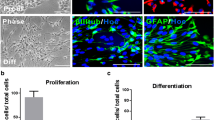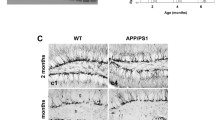Abstract
A key role of mitotic activation in neuronal cell death in early stages of Alzheimer’s disease (AD) has been suggested. Apparently, terminally differentiated neurons are precluded from mitotic division, yet some phenotypic markers of cell cycling are present in AD-vulnerable brain areas. In this paper, we investigated whether dividing human neuroblastoma cells are preferentially vulnerable to amyloid aggregate toxicity in some specific cell cycle stage(s). Our data indicate that Aβ1–40/42 aggregates added to the cell culture media bind to the plasma membrane and are internalized faster in the S than in the G2/M and G1 cells possibly as a result of a lower content in membrane cholesterol in the former. Earlier and sharper increases in reactive oxygen species production triggered a membrane oxidative injury and a significant impairment of antioxidant capacity, eventually culminating with apoptotic activation in S and, to a lesser extent, in G2/M exposed cells. G1 cells appeared more resistant to the amyloid-induced oxidative attack possibly because of their higher antioxidant capacity. The high vulnerability of S cells to aggregate toxicity extends previous data suggesting that neuronal loss in AD could result from mitotic reactivation of terminally differentiated neurons with arrest in the S phase.







Similar content being viewed by others
References
Stefani M, Dobson CM (2003) Protein aggregation and aggregate toxicity: new insights into protein folding, misfolding diseases and biological evolution. J Mol Med 81:678–699
Dobson CM (2004) Principles of protein folding, misfolding and aggregation. Semin Cell Dev Biol 15:3–16
Kayed R, Head E, Thompson JL, McIntire TM, Milton SC, Cotman CW, Glabe CG (2003) Common structure of soluble amyloid oligomers implies common mechanism of pathogenesis. Science 300:486–489
Kourie JI, Henry CL (2002) Ion channel formation and membrane-linked pathologies of misfolded hydrophobic proteins: the role of dangerous unchaperoned molecules. Clin Exp Pharmacol Physiol 29:741–753
Smith MA, Rudnicka-Nawrot M, Richey PL, Praprotnik D, Mulvihill P, Miller CA, Sayre LM, Perry G (1995) Carbonyl-related posttranslational modification of neurofilament protein in the neurofibrillary pathology of Alzheimer’s disease. J Neurochem 64:2660–2666
Markesbery WR, Carney JM (1999) Oxidative alterations in Alzheimer’s disease. Brain. Pathol 9:133–146
Mattson MP, Guo Q, Furukawa K, Pedersen WA (1998) Presenilins, the endoplasmic reticulum, and neuronal apoptosis in Alzheimer’s disease. J Neurochem 70:1–14
Cecchi C, Fiorillo C, Baglioni S, Pensalfini A, Bagnoli S, Nacmias B, Sorbi S, Nosi D, Relini A, Liguri G (2007) Increased susceptibility to amyloid toxicity in familial Alzheimer’s fibroblasts. Neurobiol Aging 28:863–876
Zhang Y, McLaughlin R, Goodyear C, LeBlanc A (2002) Selective cytotoxicity of intracellular amyloid β peptide1–42 through p53 and Bax in cultured primary human neurons. J Cell Biol 156:519–529
Velez-Pardo C, Arroyave ST, Lopera F, Castano AD, Jimenez Del Rio M (2001) Ultrastructure evidence of necrotic neural cell death in familial Alzheimer’s disease brains bearing presenilin-1 E280A mutation. J Alzheimer Dis 3:409–415
Datki Z, Juhasz A, Galfi M, Soos K, Papp R, Zadori D, Penke B (2003) Method for measuring neurotoxicity of aggregating polypeptides with the MTT assay on differentiated neuroblastoma cells. Brain Res Bull 62:223–229
Olesen OF, Dago L, Mikkelsen JD (1998) Amyloid beta neurotoxicity in the cholinergic but not in the serotonergic phenotype of RN46A cells. Brain Res Mol Brain Res 57:266–274
Copani A, Melchiorri D, Caricasole A, Martini F, Sale P, Carnevale R, Gradini R, Sortino MA, Lenti L, De Maria R, Nicoletti F (2002) Beta-amyloid-induced synthesis of the ganglioside GD3 is a requisite for cell cycle reactivation and apoptosis in neurons. J Neurosci 22:3963–3968
Frasca G, Chiechio S, Vancheri C, Nicoletti F, Copani A, Angela Sortino M (2004) Beta-amyloid-activated cell cycle in SH-SY5Y neuroblastoma cells: correlation with the MAP kinase pathway. J Mol Neurosci 22:231–236
Yang Y, Mufson E, Herrup K (2003) Neuronal cell death is preceded by cell cycle events at all stages of Alzheimer disease. J Neurosci 23:2557–2563
Khurana V, Feany MB (2007) Connecting cell-cycle activation to neurodegeneration in Drosophila. Biochim Biophys Acta 1772:446–456
Raina AK, Monteiro MJ, McShea A, Smith MA (1999) The role of cell cycle-mediated events in Alzheimer’s disease. Int J Exp Pathol 80:71–76
Hussman JW, Nochlin D, Vincent I (2000) Mitotic activation: a convergent mechanism for a cohort of neurodegenerative disease. Neurobiol Aging 21:815–828
Lie DC, Song H, Colamarino SA, Ming GL, Gage FH (2004) Neurogenesis in the adult brain: new strategies for central nervous system diseases. Annu Rev Pharmacol Toxicol 44:399–421
Kruman LI, Wersto RP, Cardozo-Pelaez F, Smilenov L, Chan SL, Chrest FJ, Emokpae R Jr, Gorospe M, Mattson MP (2004) Cell cycle activation linked to neuronal cell death initiated by DNA damage. Neuron 41:549–561
Ritzel RA, Butler PC (2003) Replication increases beta-cell vulnerability to human islet amyloid polypeptide-induced apoptosis. Diabetes 52:1701–1708
Herrup K, Neve R, Ackerman SL, Copani A (2004) Divide and die: cell cycle events as triggers of nerve cell death. J Neurosci 24:9232–9239
Park DS, Levine B, Ferrari G, Greene LA (1997) Cyclin dependent kinase inhibitors and dominant negative cyclin dependent kinase 4 and 6 promote survival of NGF-deprived sympathetic neurons. J Neurosci 17:8975–8983
Dahlgren KN, Manelli AM, Stine WB, Baker LK, Krafft GA, LaDu MJ (2002) Oligomeric and fibrillar species of amyloid-beta peptides differentially affect neuronal viability. J Biol Chem 277:32046–32053
Lange Y, Ramos BV (1983) Analysis of the distribution of cholesterol in the intact cell. J Biol Chem 258:15130–15134
Datki Z, Papp R, Zadori D, Soos K, Fulop L, Juhasz A, Laskay G, Hetenyi C, Mihalik E, Zarandi M et al (2004) In vitro model of neurotoxicity of Abeta 1–42 and neuroprotection by a pentapeptide: irreversible events during the first hour. Neurobiol Dis 17:507–515
Cecchi C, Baglioni S, Fiorillo C, Pensalfini A, Liguri G, Nosi D, Rigacci S, Bucciantini M, Stefani M (2005) Insights into the molecular basis of the differing susceptibility of varying cell types to the toxicity of amyloid aggregates. J Cell Sci 118:3459–3470
Bradford MM (1976) A rapid and sensitive method for the quantitation of microgram quantities of protein utilizing the principle of protein-dye binding. Anal Biochem 72:248–254
Arispe N, Doh M (2002) Plasma membrane cholesterol controls the cytotoxicity of Alzheimer’s disease AbetaP (1–40) and (1–42) peptides. FASEB J 16:1526–1536
Martindale JL, Holbrook NJ (2002) Cellular response to oxidative stress: signaling for suicide and survival. J Cell Physiol 192:1–15
Asnaghi L, Bruno P, Priulla M, Nicolin A (2004) mTOR: a protein kinase switching between life and death. Pharmacol Res 50:545–549
Cooper S (2004) Rejoinder: whole-culture synchronization cannot, and does not, synchronize cells. Trends Biotechnol 22:274–276
Spellman PT, Sherlock G (2004) Final words: cell age and cell cycle are unlinked. Trends Biotecnol 22:277–278
Lacor PN, Buniel MC, Chang L, Fernandez SJ, Gong Y, Viola KL, Lambert MP, Velasco PT, Bigio EH, Finch CE, Krafft GA, Klein WI (2004) Synaptic targeting by Alzheimer’s-related amyloid β oligomers. J Neurosci 24:10191–10200
Shaked GM, Kummer MP, Lu DC, Galvan V, Bredesen DE, Koo EH (2006) Abeta induces cell death by direct interaction with its cognate extracellular domain on APP (APP 597–624). FASEB J 20:1254–1256
Yip CM, Elton EA, Darabie AA, Morrison MR, McLaurin J (2001) Cholesterol, a modulator of membrane-associated Abeta-fibrillogenesis and neurotoxicity. J Mol Biol 311:723–734
Kakio A, Nishimoto S-L, Kozutsumi Y, Matsuzaki K (2003) Formation of membrane-active form of amyloid β-protein in raft-like model membranes. Biochim Biophys Res Commun 303:514–518
Abad-Rodriguez J, Ledesma MD, Craessaerts K, Perga S, Medina M, Delacourte A, Dingwall C, De Strooper B, Dotti CG (2004) Neuronal membrane cholesterol loss enhances amyloid peptide generation. J Cell Biol 167:953–960
Kojro E, Gimp G, Lammrich S, März W, Fahrenholz F (2001) Low cholesterol stimulates the nonamyloidogenic pathway by its effect on the a-secretase ADAM 10. Proc Natl Acad Sci USA 98:5815–5820
Benvenuti S, Saccardi R, Luciani P, Urbani S, Deledda C, Cellai I, Arancini F, Squecco R, Rosati F, Danza G, Gelmini S, Greeve I, Rossi M, Maggi R, Serio M, Peri A (2006) Neuronal differentiation of human mesenchymal stem cells: changes in the expression of the Alzheimer’s disease-related gene seladin-1. Exp Cell Res 312:2592–2604
Greeve I, Hermans-Borgmeyer I, Brellinger C, Kasper D, Gomez-Isla T, Behl C, Levkau B, Nitsch RM (2000) The human DIMINUTO/DWARF1 homolog seladin-1 confers resistance to Alzheimer’s disease-associated neurodegeneration and oxidative stress. J Neurosci 20:7345–7352
Schwab BL, Guerini D, Didszun C, Bano D, Ferrando-May E, Fava E, Tam J, Xu D, Xanthoudakis S, Nicholson DW et al (2002) Cleavage of plasma membrane calcium pumps by caspases: a link between apoptosis and necrosis. Cell Death Differ 9:818–831
Squier TC (2001) Oxidative stress and protein aggregation during biological aging. Exp Gerontol 36:1539–1550
Lie DC, Song H, Colamarino SA, Ming GL, Gage FH (2004) Neurogenesis in the adult brain: new strategies for central nervous system diseases. Annu Rev Pharmacol Toxicol 44:399–421
Haughey NJ, Nath A, Chan SL, Borchard AC, Rao MS, Mattson MP (2002) Disruption of neurogenesis by amyloid beta-peptide, and perturbed neural progenitor cell homeostasis, in models of Alzheimer’s disease. J Neurochem 83:1509–1524
Acknowledgments
This study has been supported by grants from the Italian MIUR (project numbers 2005054147_001 and 2005053998_001) from the Ente Cassa di Risparmio di Firenze (ref. no. 2005.0701) and from the Compagnia di San Paolo, Torino, Italy (ref. no. 2004.0995). All authors declare the absence of any actual or potential conflicts of interest including any financial, personal or other relationships with other people or organizations within 2 years of beginning the work submitted that could inappropriately influence (bias) their work. All data contained in the manuscript being submitted have not been previously published, have not been submitted elsewhere, and will not be submitted elsewhere while under the consideration at the Journal of Molecular Medicine. All authors have reviewed the contents of the manuscript being submitted, approve of its contents, and validate the accuracy of the data.
Author information
Authors and Affiliations
Corresponding author
Rights and permissions
About this article
Cite this article
Cecchi, C., Pensalfini, A., Stefani, M. et al. Replicating neuroblastoma cells in different cell cycle phases display different vulnerability to amyloid toxicity. J Mol Med 86, 197–209 (2008). https://doi.org/10.1007/s00109-007-0265-3
Received:
Revised:
Accepted:
Published:
Issue Date:
DOI: https://doi.org/10.1007/s00109-007-0265-3




